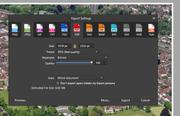kevinbecken wrote:Hi, Printers recommend a resolution of 300 pixels per inch to retain the best image quality. Also remember to add bleed size to the image, usually 3mm beyond the print size, if you want your images to print to the very edge of the paper.
Document resolution is separate from the question of the best JPEG compression setting.
There’s a section of PagePlus where you can specify the amount of bleed, if any. This is generally preferable to increasing the page size to allow for bleed.
kevinbecken wrote:If your images have multiple layers, with any transparency, then the safest option is to merge the layers to a flat image, else you can have problems.
JPEG is a flat file format that doesn’t support transparency, so any layers will automatically be combined and any transparent areas will automatically become white when you export to JPEG.
kevinbecken wrote:Printers also say to submit CMYK, but I have always stuck to RGB and let the printer do the conversion. I've found PP will distort the RGB to CMYK conversion colours.
The experience that you describe seems to be quite common, Kevin. I suspect it would be less of a problem if printers gave proper advice about which particular CMYK profile to use, but in the absence of such information I think your recommendation of sticking to RGB is very good advice.
kevinbecken wrote:I always output to PDF, and the printer I use can handle any version of this.
One of the ‘flavours’ of PDF/X should be suitable, but it’s always best to ask your printer what they would prefer.
"I am ignorant of absolute truth. But I am humble before my ignorance, and therein lies my honour and my reward.”
— Kahlil Gibran
